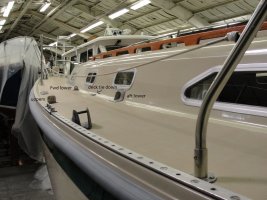CaptDan
Member III
Hey E35II Vikings,
I don't know how many of you read Good Old Boat magazine. In this (September/October) issue, N.A. Ted Brewer - who writes a regular boat comparisons article - discusses the similarity between the '60s/70s Mistral 33, Seafarer 34 and Ericson 35-2. Accompanying this latest installment are line drawings, one of which, of an E35II with a single lower shroud. Further, he contends - mistakenly, I assume - the model, indeed, features a single lower.
I've written a response, which the magazine's editor is forwarding to Ted Brewer for elaboration. Long story short, every E35II I've seen features double fore/aft lowers. Did I miss a version or year that didn't?
PS: Mr Brewer speaks glowingly of the E35 - opinions I WOULDN'T disagree with.
Thanks.
Capt Dan G>E35II "Kunu"
I don't know how many of you read Good Old Boat magazine. In this (September/October) issue, N.A. Ted Brewer - who writes a regular boat comparisons article - discusses the similarity between the '60s/70s Mistral 33, Seafarer 34 and Ericson 35-2. Accompanying this latest installment are line drawings, one of which, of an E35II with a single lower shroud. Further, he contends - mistakenly, I assume - the model, indeed, features a single lower.
I've written a response, which the magazine's editor is forwarding to Ted Brewer for elaboration. Long story short, every E35II I've seen features double fore/aft lowers. Did I miss a version or year that didn't?
PS: Mr Brewer speaks glowingly of the E35 - opinions I WOULDN'T disagree with.

Thanks.
Capt Dan G>E35II "Kunu"

